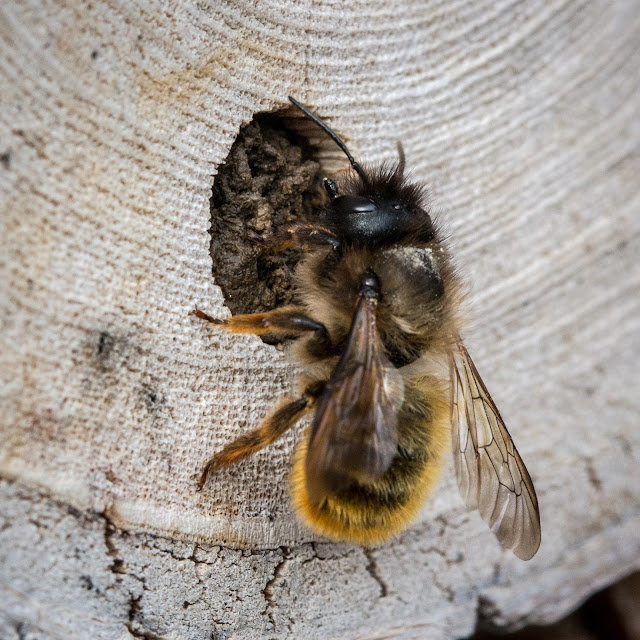The first red mason bees were out early this year. I saw males on 15th April which is more than two weeks earlier than usual, although these were on the apple blossom and the dead sycamores whereas I probably concentrated more on the bee house in previous years.

I saw the first female on 27th April, again in the sycamore rather than the bee house.
One female has been building a nest in the bee house. Because the finished nests in previous years were attacked by woodpeckers, blue tits and magpies the bee house is now protected by a wire mesh about 3-4cm in front of the holes. The bees have no difficulty navigating the mesh although I remove it for taking photos. Here are a couple of photos of the bee bringing in mud to build the cell walls.

Red mason bees collect pollen from a wide variety of flowers but it seems always to be yellow. This one is on broccoli.
And here is the bee bringing in pollen to provision the cells. It is carried on the scopa on the underside of her abdomen.

The hole has a diameter of 8mm which is too small for her to turn around so she goes in head first to deposit some nectar and then returns to the entrance to turn around before reversing in to offload the pollen.
Here is a short video.
The last job is to seal the entrance. The mud plug was about 5mmm thick.


When this bee finished she checked out a few adjacent holes and started work again in the hole above. However, only a couple of hours later she was again sealing the hole so I think there can have been only one or two cells completed in the top one. The second mud plug was about 8mm thick - quite a lot of mud sorties. You can see woodpecker damage from previous years on two holes in this photo. The small holes are occupied by tiny black wasps.
And this is how it ends.
















Very nice pictures documenting their lifestyle.
ReplyDeleteLoved the red mason bee studies, Christopher! I'm inspired to drill a few blocks of wood for them myself (with wire mesh bird excluders, of course).
ReplyDelete
DeleteThanks Florence. They have been keeping me entertained during the lockdown. I will have more videos to post in the next few days. If you do try, use a variety of different drill sizes 2-8mm as all sorts of small creatures turn up and use them. I was sorry to read about your honey bees. I hope you get more in due course. Mine have also been keeping me entertained.
The music was perfect Chris!
ReplyDelete